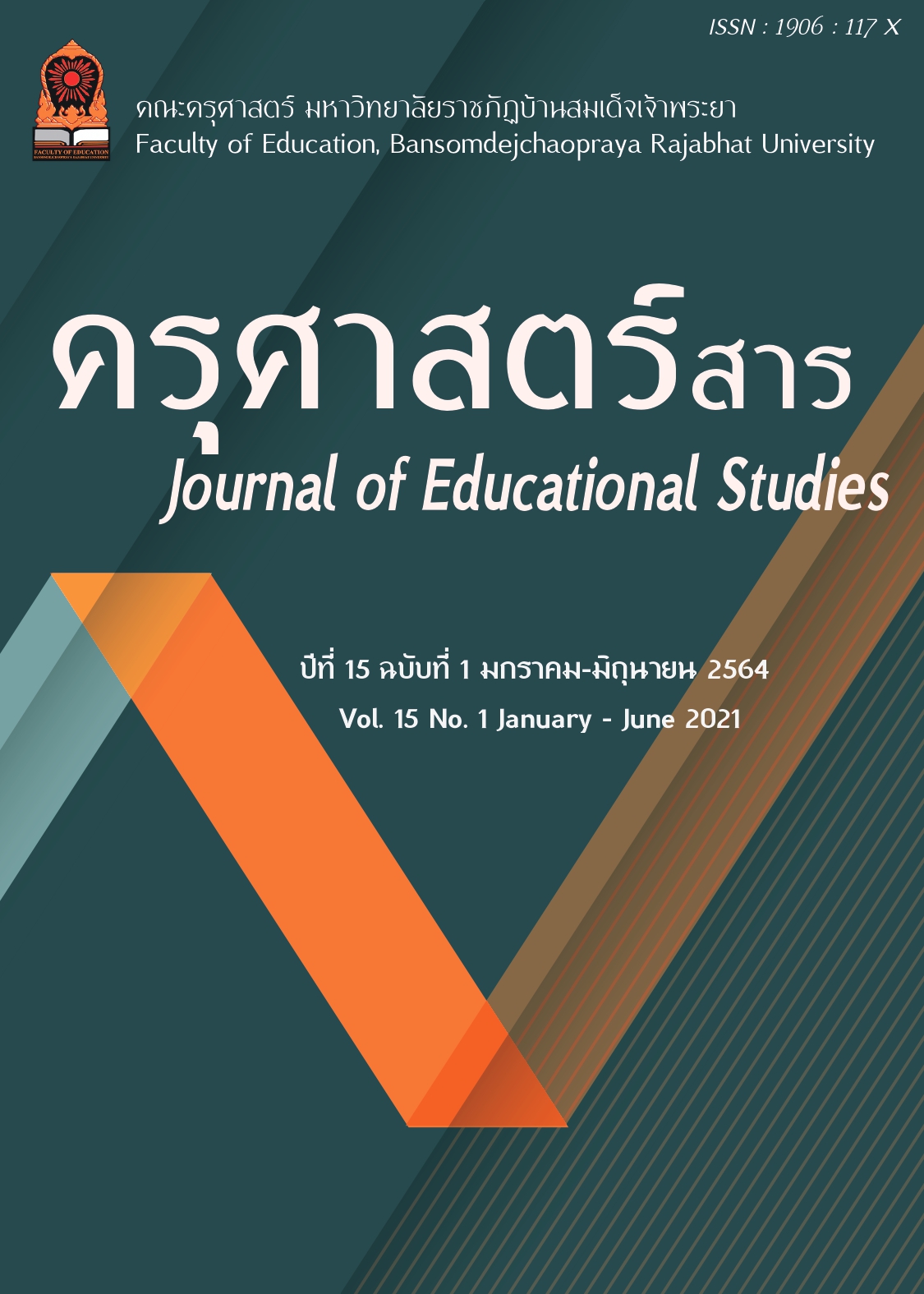วารสาร
การวิเคราะห์องค์ประกอบเชิงยืนยันในการวัดกรอบคิดแบบเติบโตและการปฏิบัติการประเมินในชั้นเรียนของครู
กัญภ์หัชรินดา เภสัชชา
จุฬาลงกรณ์มหาวิทยาลัย
กนิษฐ์ ศรีเคลือบ
จุฬาลงกรณ์มหาวิทยาลัย
บทคัดย่อ
การประเมินของครูมีความสำคัญต่อครูในการจัดการเรียนการสอนเพื่อใช้ในการพัฒนานักเรียน ซึ่งกรอบคิดด้านการประเมินของครูมีความสัมพันธ์กับวิธีการที่ครูปฏิบัติ อีกทั้งกรอบคิดด้านการวัดและประเมินและการปฏิบัติด้านการวัดและประเมินของครูเป็นสิ่งที่สำคัญซึ่งจะนำไปสู่การพัฒนาการเรียนรู้ของนักเรียน ในการวิจัยครั้งนี้มีจุดประสงค์เพื่อวิเคราะห์องค์ประกอบของกรอบคิดและการปฏิบัติด้านการวัดและประเมินผู้เรียนของครู และเพื่อพัฒนาเครื่องมือวัดกรอบคิดและการปฏิบัติด้านการวัดและประเมินผู้เรียนของครู ผลการวิจัยสรุปได้ดังนี้ การวัดกรอบคิดผ่านสิ่งที่บุคคลตอบสนองต่อสถานการณ์ 3 องค์ประกอบ (tricomponent) ได้แก่ ความคิด ความรู้สึก และพฤติกรรมของ Dweck, Walton, and Cohen (2011) มาพิจารณาประกอบกับแนวคิดขั้นตอนการปฏิบัติการประเมินในชั้นเรียน 3 ขั้นตอน ได้แก่ การเลือกวิธีการวัดและประเมิน การเลือกเครื่องมือวัดและประเมิน และการใช้ผลการประเมิน ได้เป็นตัวบ่งชี้หรือตัวแปรสังเกตได้ 9 ตัวแปร ได้แก่ ความคิดการเลือกวิธีการวัดและประเมิน ความคิดการเลือกเครื่องมือวัดและประเมิน ความคิดการใช้ผลการประเมิน ความรู้สึกการเลือกวิธีการวัดและประเมิน ความรู้สึกการเลือกเครื่องมือวัดและประเมิน ความรู้สึกการใช้ผลการประเมิน พฤติกรรมการเลือกวิธีการวัดและประเมิน พฤติกรรมการเลือกเครื่องมือวัดและประเมิน และพฤติกรรมการใช้ผลการประเมิน ผลผลิตที่ได้จากการวิจัย คือ การสร้างแบบวัด โดยอิงแนวคิดของการวัดแบบพหุมิติภายในข้อคำถาม (multidimensional within item) มีลักษณะเป็นมาตรประมาณค่า 5 ระดับ (rating scale) แสดงดังตาราง 1 จำนวน 15 ข้อ เพื่อเป็นประโยชน์ต่อการนำไปศึกษาลักษณะและความสัมพันธ์ของกรอบคิดและการปฏิบัติด้านการวัดและประเมินผู้เรียนของครู
Abstract
Teacher evaluation is important to teachers in teaching to be used in student development. The teacher's assessment framework is correlated with how teachers practice, as well as the teacher's measurement and evaluation framework, which leads to the development of students' learning. This research aims to analyze the composition of the thinking framework and practice of measuring and evaluating teachers. To develop the teacher's thinking and evaluation framework measurement tools and practices. The findings are summarized as follows: Measuring the framework through what a person responds to three tricomponent scenarios: thoughts, feelings, and behaviors of Dweck, Walton, and Cohen (2011) to consider the concept of three class assessment procedures: the selection of measurement and evaluation methods. Selecting measurement and evaluation instruments and using assessment results is an indicator or variable of 9 observable variables: thinking, choosing measurement and evaluation methods. Ideas, selection, measurement and evaluation instruments Thoughts on the use of evaluation results Feelings, choosing how to measure and evaluate Feelings, selection, measurement and evaluation instruments Feelings using the evaluation results Behavior, selection, measurement and evaluation methods Measurement and evaluation instrument selection behavior, and evaluation evaluation behavior. The results of the research are the creation of a measurement based on the concept of multidimensional within item, which is characterized by a 5-scale estimate, shown as shown in Table 1 of 15, to be useful in the study of the characteristics and relationships of the teacher's thinking and practice framework.
คำสำคัญ
กรอบคิดแบบเติบโตและการปฏิบัติการประเมินในชั้นเรียนของครู, การวิเคราะห์องค์ประกอบเชิงยืนยัน
Keywords
Classroom Assessment Growth Mindset And Practice Of Teachers, Confirmatory Factor Analysis
เอกสารอ้างอิง
ณัฐฌา ไกยะฝ่าย, วัลนิกา ฉลากบาง, และ วันเพ็ญ นันทะศรี. (2562). การพัฒนารูปแบบเพื่อเสริมสร้างสมรรถนะด้านการวัดและประเมินผลการเรียนรู้ สำหรับครูในโรงเรียนสังกัดเทศบาลนครสกลนคร. Nakhon Phanom University Journal, 9(1), 68-75.
วิภาวี ศิริลักษณ์. (2561). การวิจัยการออกแบบและการศึกษาประสบการณ์ผู้ใช้เพื่อพัฒนาหลักการออกแบบและต้นแบบ การส่งเสริมกรอบคิดทางบวกด้านการวิจัยของครู (วิทยานิพนธ์ ปริญญาดุษฎีบัณฑิต). จุฬาลงกรณ์มหาวิทยาลัย, กรุงเทพฯ.
ศุภมาส ชุมแก้ว. (2559). อิทธิพลเชิงสาเหตุของการรู้เรื่องการประเมิน ของครู: การวิเคราะห์โมเดลสมการโครงสร้างพหุระดับที่มี สมรรถนะการประเมินของผู้บริหารเป็นตัวแปรปรับ (วิทยานิพนธ์ ปริญญาดุษฎีบัณฑิต). จุฬาลงกรณ์มหาวิทยาลัย, กรุงเทพฯ.
ศุภมาส ชุมแก้ว. (2561). การ ประเมิน ความ ต้องการ จำเป็น การ รู้ เรื่อง การ ประเมิน ของ ครู. วารสาร วิทยบริการ มหาวิทยาลัยสงขลานครินทร์| Academic Services Journal, Prince of Songkla University, 29(1), 88-94. http://dx.doi.org/10.14456/asj-psu.2018.6
สำนักงานเลขาธิการสภาการศึกษามาตรฐานการศึกษาของชาติ. (2561). มาตรฐานการศึกษาของชาติ พ.ศ. 2561.
อนันดา สัณฐิติวณิชย์. (2556), การพัฒนาลักษณะเฉพาะของแบบสอบที่บูรณาการระหว่างตัวชี้วัดความ สามารถด้านการอ่าน การคิดวิเคราะห์และการเขียนกับตัวชี้วัดการประเมินสาระการเรียนรู้: การประยุกต์ ใช้ทฤษฎีการตอบสนองข้อสอบแบบพหุมิติ (วิทยานิพนธ์ ปริญญาดุษฎีบัณฑิต). จุฬาลงกรณ์มหาวิทยาลัย, กรุงเทพฯ.
Adams, R. J., Wilson, M., & Wang, W. C. (1997). The multidimensional random coefficients multinomial logit model. Applied psychological measurement, 21(1), 1-23. https://doi.org/10.1177/0146621697211001
Brown, G. T. (2004). Teachers' conceptions of assessment: Implications for policy and professional development. Assessment in Education: Principles, Policy & Practice, 11(3), 301-318. https://doi.org/10.1080/0969594042000304609
DeLuca, C., Coombs, A., & LaPointe-McEwan, D. (2019). Assessment mindset: Exploring the relationship between teacher mindset and approaches to classroom assessment. Studies in Educational Evaluation, 61, 159-169. https://doi.org/10.1016/j.stueduc.2019.03.012
Dweck, C. (2015). Carol Dweck revisits the growth mindset. Education Week, 35(5), 20-24.
Dweck, C. S. (2006). Mindset: The new psychology of success. Random House.
Dweck, C. S., Walton, G. M., & Cohen, G. L. (2014). Academic Tenacity: Mindsets and Skills that Promote Long-Term Learning. Bill & Melinda Gates Foundation.
Edwards, F. (2013). Quality assessment by science teachers: Five focus areas. Science Education International, 24(2), 212-226. https://files.eric.ed.gov/fulltext/EJ1015826.pdf
Fives, H., & Barnes, N. (2017). Informed and uninformed naive assessment constructors’ strategies for item selection. Journal of Teacher Education, 68(1), 85–101. https://doi.org/10.1177/0022487116668019
Jensen, S. (2007). Mindset for assessment. Faculty guidebook: A comprehensive tool for improving faculty performance. http://www.ece.uidaho.edu/ee/power/jlaw/COURSES/CAPSTONE/F05/handouts/Mindset_assessment082605.pdf
Joint Committee on Standards for Educational Evaluation. (2015). Classroom assessment standards: Practices for PK-12 teachers. http://www.jcsee.org/the-classroom-assessment-standards-new-standards
Masters, G. N. (2013). Towards a growth mindset in assessment. Australian Council for Education Research. https://research.acer.edu.au/ar_misc/17
McMillan, J. H. (2015). Classroom assessment. International Encyclopedia of the Social & Behavioral Sciences (Second Edition), 3, 1978–1983. https://doi.org/10.1016/B978-0-08-097086-8.92074-9
Pellegrino, J. W. (2012). Assessment of science learning: Living in interesting times. Journal of Research in Science Teaching, 49, 831–841.https://doi.org/10.1002/tea.21032
Remesal, A. (2011). Primary and secondary teachers’ conceptions of assessment: A qualitative study. Teaching and teacher education, 27(2), 472-482. https://doi.org/10.1016/j.tate.2010.09.017
Shermis, M. D., & DiVesta, F. J. (2011). Classroom assessment in action. Rowman & Littlefield Publishers.
Siegel, M. A., & Wissehr, C. (2011). Preparing for the plunge: Preservice teachers’ assessment literacy. Journal of Science Teacher Education, 22(4), 371-391. https://doi.org/10.1007/s10972-011-9231-6
Trigwell, K., & Prosser, M. (2004). Development and use of the approaches to teaching inventory. Educational Psychology Review, 16(4), 409-424. https://doi.org/10.1007/s10648-004-0007-9
Willis, J., Adie, L., & Klenowski, V. (2013). Conceptualising teachers’ assessment literacies in an era of curriculum and assessment reform. The Australian Educational Researcher, 40(2), 241-256. https://doi.org/10.1007/s13384-013-0089-9
Willis, J., Adie, L., & Klenowski, V. (2013). Conceptualising teachers’ assessment literacies in an era of curriculum and assessment reform. The Australian Educational Researcher, 40(2), 241-256. https://doi.org/10.1007/s13384-013-0089-9
Yamtim, V., & Wongwanich, S. (2014). A study of classroom assessment literacy of primary school teachers. Procedia-Social and Behavioral Sciences, 116, 2998-3004. https://doi.org/10.1016/j.sbspro.2014.01.696
Yeager, D. S., & Dweck, C. S. (2012). Mindsets that promote resilience: When students believe that personal characteristics can be developed. Educational psychologist, 47(4), 302-314. https://doi.org/10.1080/00461520.2012.722805
Zeeb, H., Ostertag, J., & Renkl, A. (2020). Towards a Growth Mindset Culture in the Classroom: Implementation of a Lesson-Integrated Mindset Training. Education Research International, 2020, 1-13. https://doi.org/10.1155/2020/8067619
